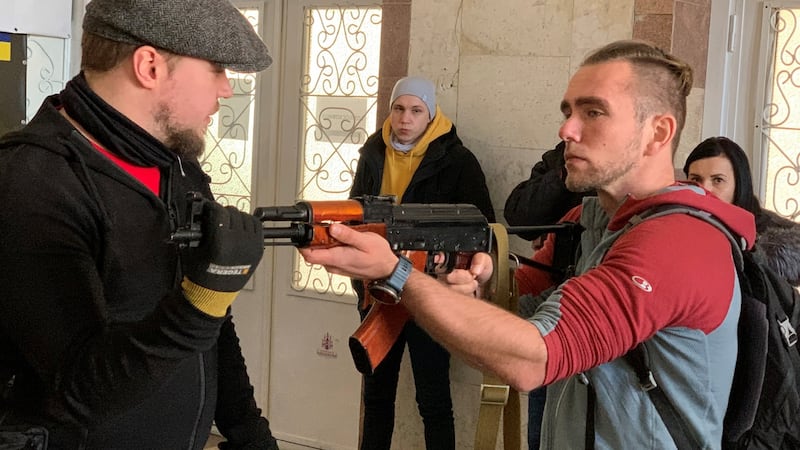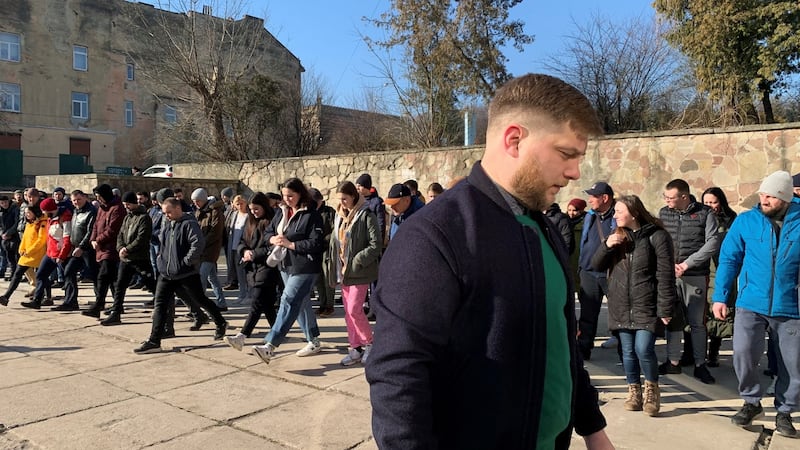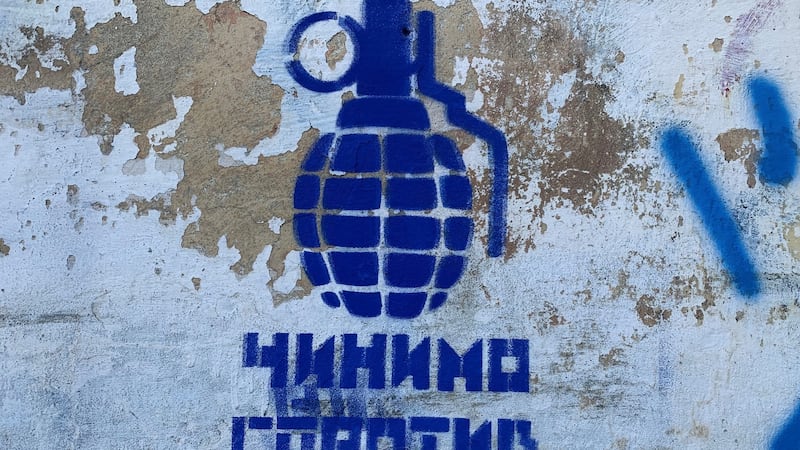They gather outside a school and sports complex in central Lviv early every morning, ordinary Ukrainian men and women from all walks of life. Some want to protect themselves and their families if Russian ground forces enter their city. More say they will be active members of the resistance.
While we wait for instructors to arrive, I strike up a conversation with Solomiya Ilechko, a 24-year-old nail artist, and Mariana Oliynyk (27), a pharmacist. "If the war comes to Lviv, I want to be ready," says Ilechko. "I want to learn to use weapons and treat wounds."
Oliynyk has some medical training as a pharmacist, but she wants to learn more. Her brother is married to Ilechko’s sister, and the young women are as close as sisters. “We tried to buy guns but there are none left,” Oliynyk says.

The young women alternate between their normal jobs and the volunteer centre in Kopernika Street, where they sort medicine and clothing for refugees, make camouflage nets and prepare food for the army.
They admit to occasional depression. “I try to chase it away by talking with Solomiya and my family,” says Oliynyk. “Hugging lifts your morale too,” Ilechko adds. Both are single. The safety of their families is their primary concern. Ilechko’s father is in the Territorial Defence Forces (TDF) and she sleeps badly when he is on duty.


Kostya Leschenko (34) is a software engineer who learned about the one-day course by word of mouth. He has already signed up for the TDF and also joined a volunteer civil defence organisation. "All Lviv is working to supply the front lines," he says. "If the Russians come here, I will definitely be in the resistance. Most of the people in this class are preparing to be resisters."
Leschenko has already contributed close to €20,000 – the equivalent of more than four months’ salary – to the war effort, on the Ukrainian government website and to Come Back Alive, the main organisation that is helping soldiers.
Courage
Asked if he would have the courage to attack Russian troops, Leschenko does not hesitate. “Yes. I am very angry. Every Ukrainian is very angry.” A co-worker, a young woman called Anastasia, was shot dead by the Russians last week. “She loved animals and was driving to feed them at a shelter outside Kyiv. All three people in the car were killed.”
The instructors arrive just after 9am with cries of “Glory to Ukraine”, which are echoed by the students.
Your finger should always be on the safety catch. If you keep your finger on the trigger and trip, you may shoot yourself
Oleksii Chyzhenko (55), an army reservist, begins by apologising for speaking Russian. "I am very sorry. I am from the east. I am a Ukrainian citizen," he says.
Chyzhenko holds up a Kalashnikov 74, an improved version of the famous AK-47. “Your finger should always be on the safety catch. If you keep your finger on the trigger and trip, you may shoot yourself. You have to support the gun with your left hand,” he begins. “Your shoulder is important for support, and to ease the weight. This is the magazine. This is how you load it.”
Henry Reed’s second World War poem The Naming of Parts flashes into my mind. “And this you can see is the bolt. The purpose of this/ Is to open the breech, as you see. We can slide it/ Rapidly backwards and forwards: we call this/ Easing the spring.”
Field geometry
Chyzhenko dispenses advice. If you’re an amateur, “you won’t be able to hit anything farther than 200 metres” . There’s an incomprehensible foray into field geometry to teach us how to calculate distances. One should wear headphones if possible, or at least stuff cotton in the ears.
“If you’ve never shot before, the sound will be obnoxious to you... It’s important not to lose sight of your target while recharging... Hold your breath when you shoot. If you keep breathing you will be inaccurate... Bend your knees a little. Lean slightly forward. Don’t do this out in the open or you will probably get killed. Use a corner... If you are a civilian, shoot and leave... If you get wounded, you will be a burden to soldiers.”


Chyzhenko shows us two models of hand grenades. One spreads shrapnel in a radius of 25 metres; the other 200 metres. “If you see one on the ground, lie down. Put your feet flat to either side and cover your head until it explodes. This will do the least damage to you.” If you see the bigger grenade model, “you have to find cover, even if it’s only a small hole in the ground. It explodes four seconds after being thrown. You have three seconds to take cover.”
Chyzhenko shows us how to remove the grenade pin. “This is how you pull the ring and throw the grenade. Once you have pulled the ring, you must throw it.”
In the basement gym, surrounded by weight machines, Daryna Pryimak, a 25-year-old sixth-year medical student, is teaching how to treat war wounds, a class that is strangely more disturbing than the weapons lessons.
A student lies on an exercise mat. “If the person is unconscious, put your face next to their nostrils to see if they are breathing,” Pryimak says. If a person pants like a dog, they may be suffering from pneumothorax, a collapsed lung, which can be caused by a bullet wound.
Puncture
Using a plastic bag as the model of a lung, Pryimak explains how to puncture the chest wall with a needle, to relieve pressure. “The most important thing is to find the wound and stop the bleeding, with an occlusive bandage if you have one. Or plug the hole with surgical gloves. Tape is better than nothing... If you don’t stop the bleeding, the person will die. The rest you can do when you get to shelter.”
Back upstairs, the weapons class has split in two, so that every student can manipulate a Kalashnikov. There are only two Kalashnikovs and no live ammunition. One hundred students enrol every day, and there is a waiting list.
I watch Ilechko remove and reinsert the magazine and pull the trigger with aplomb, despite her long pink fingernails. She tells me the weapon is heavy, that she feels the blood rush to her cheeks when she fires it.
Ilechko isn’t sure she could kill a Russian soldier. “I won’t know until I’m in that situation,” she says. “If he threatens my life or my family, I would have to do it.”

Weapons instructor Tomi Hiltunen (32) is a Finnish software programmer who travelled to Ukraine with the Lithuanian group Luksu Vyrai, named after partisans who fought the Soviets. The Lithuanians have ferried food, clothes, helmets and bulletproof vests to Ukraine. A convoy from Poland was to deliver ten airsoft weapons for teaching purposes that same day.
How useful is one day’s training, with no live ammunition? I ask Hiltunen. “It’s better than nothing,” he replies. “If there are no real weapons available, they can practise with an airsoft.”
Officials distributed 18,000 Kalashnikovs in Kyiv, and will do the same in Lviv if the Russians approach the western city, Hiltunen says. He did a year's military service in Finland, then joined the reserves and is an avid practitioner of the Finnish sport SRA-shooting.
Hiltunen was never attracted to conflicts in the Middle East or Africa, because their culture was alien to him, he says. "This is closer. It carries a lot of meaning for us. We share a thousand-kilometre border with Russia. We fought two wars with the Soviets and they seized the Karelia and Petsamo regions of Finland."
The Finns who lived in those regions were deported to Siberia and replaced with Russians. “The Soviets changed the population. The Russians follow the same scenario everywhere, like a schoolbook,” Hiltunen says. “I want to help in any way I can. If Ukraine falls, Sweden, Finland and the Baltics are going to be next.”











